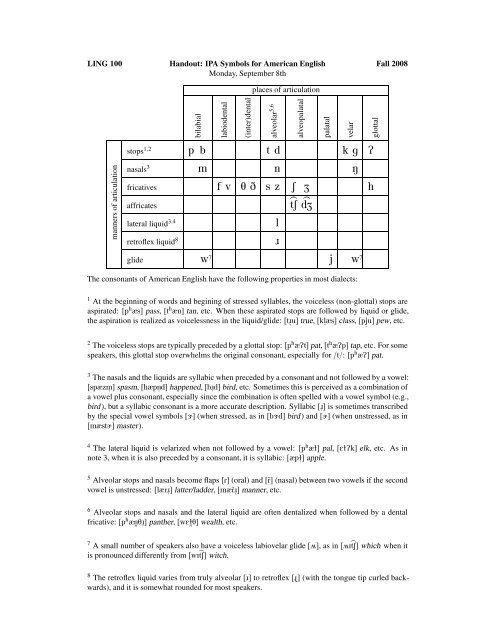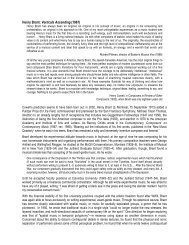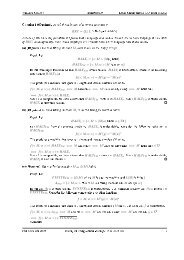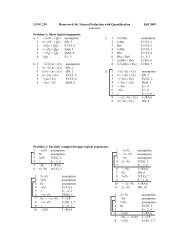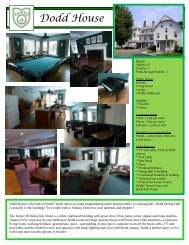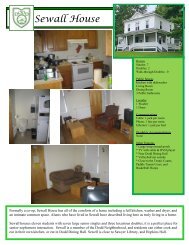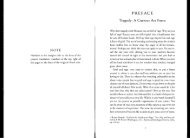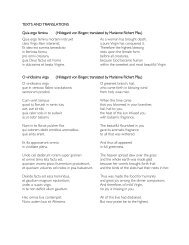handout: IPA symbols for American English
handout: IPA symbols for American English
handout: IPA symbols for American English
You also want an ePaper? Increase the reach of your titles
YUMPU automatically turns print PDFs into web optimized ePapers that Google loves.
LING 100 Handout: <strong>IPA</strong> Symbols <strong>for</strong> <strong>American</strong> <strong>English</strong> Fall 2008<br />
Monday, September 8th<br />
places of articulation<br />
manners of articulation<br />
bilabial<br />
labiodental<br />
(inter)dental<br />
alveolar 5,6<br />
alveopalatal<br />
palatal<br />
velar<br />
glottal<br />
stops 1,2 p b t d k g P<br />
nasals 3 m n N<br />
fricatives f v T D s z S Z h<br />
> ><br />
affricates<br />
tS dZ<br />
lateral liquid 3,4<br />
retroflex liquid 8<br />
l<br />
ô<br />
glide w 7 j w 7<br />
The consonants of <strong>American</strong> <strong>English</strong> have the following properties in most dialects:<br />
1 At the beginning of words and begining of stressed syllables, the voiceless (non-glottal) stops are<br />
aspirated: [p h æs] pass, [t h æn] tan, etc. When these aspirated stops are followed by liquid or glide,<br />
the aspiration is realized as voicelessness in the liquid/glide: [tô˚u] true, [kl˚æs] class, [pju] pew, etc.<br />
˚<br />
2 The voiceless stops are typically preceded by a glottal stop: [p h æPt] pat, [t h æPp] tap, etc. For some<br />
speakers, this glottal stop overwhelms the original consonant, especially <strong>for</strong> /t/: [p h æP] pat.<br />
3 The nasals and the liquids are syllabic when preceded by a consonant and not followed by a vowel:<br />
[spæzm "<br />
] spasm, [hæpn "<br />
d] happened, [bô "<br />
d] bird, etc. Sometimes this is perceived as a combination of<br />
a vowel plus consonant, especially since the combination is often spelled with a vowel symbol (e.g.,<br />
bird), but a syllabic consonant is a more accurate description. Syllabic [ô "<br />
] is sometimes transcribed<br />
by the special vowel <strong>symbols</strong> [Ç] (when stressed, as in [bÇd] bird) and [Ä] (when unstressed, as in<br />
[mæstÄ] master).<br />
4 The lateral liquid is velarized when not followed by a vowel: [p h æë] pal, [EëPk] elk, etc. As in<br />
note 3, when it is also preceded by a consonant, it is syllabic: [æpë "<br />
] apple.<br />
5 Alveolar stops and nasals become flaps [R] (oral) and [˜R] (nasal) between two vowels if the second<br />
vowel is unstressed: [læRô "<br />
] latter/ladder, [mæ˜Rô "<br />
] manner, etc.<br />
6 Alveolar stops and nasals and the lateral liquid are often dentalized when followed by a dental<br />
fricative: [p h æn”Tô "<br />
] panther, [wEë”T] wealth, etc.<br />
7 A small number of speakers also have a voiceless labiovelar glide [û], as in [ûI > tS] which when it<br />
is pronounced differently from [wI > tS] witch.<br />
8 The retroflex liquid varies from truly alveolar [ô] to retroflex [õ] (with the tongue tip curled backwards),<br />
and it is somewhat rounded <strong>for</strong> most speakers.
front<br />
i 1<br />
central back<br />
high 1 u 1,3<br />
I<br />
U 3<br />
ej 2<br />
ow 2<br />
mid<br />
2/@ 5 diphthongs: aj aw Oj<br />
E<br />
O 4<br />
low<br />
æ<br />
A<br />
The vowels of <strong>American</strong> <strong>English</strong> have the following properties in most dialects:<br />
1 Many speakers realize the tense high vowels as slight diphthongs [ij uw].<br />
2 The tense mid vowels are usually realized as diphthongs [ej ow], but they can be monophthongs<br />
[e o], depending on the speaker’s dialect, surrounding sounds, rate of speech, etc.<br />
3 In many dialects (especially in the Western and Southern US), the high back round vowels are<br />
often pronounced with less lip rounding than other round vowels and/or a bit fronter than other back<br />
vowels. This is especially true <strong>for</strong> [U].<br />
4 In many dialects (especially in the Western US), the lax mid back vowel [O] is only found be<strong>for</strong>e<br />
[ô], as in [fOôs] <strong>for</strong>ce. Many other dialects (especially in the Northeastern US) contrast [O] and low<br />
back [A] in pairs like [kOt] caught versus [kAt] cot.<br />
5 The mid central vowels are distinguished by stress: [2] is always stressed, while [@] (a.k.a. schwa)<br />
is always unstressed. Schwa is also called a reduced vowel, because it is much shorter and weaker<br />
than other vowels, even unstressed vowels. Schwa varies quite a lot in pronunciation, sometimes<br />
higher [1] and sometimes also fronter [I], depending on the surrounding consonants.<br />
6 When the end of the syllable contains only voiced consonants, any stressed vowel is usually lengthened:<br />
[lu:z] lose versus [lus] loose, [hA:ôd] hard versus [haôt] welt.<br />
7 When a vowel is followed by a nasal stop in the same syllable, the vowel is (at least partially)<br />
nasalized (and if the conditions in Note 6 are met, it will also be lengthened): [bẼnt] bent, [bẼ:nd]<br />
bend, [lũ:m] loom, [lũ:n] loon, etc.


